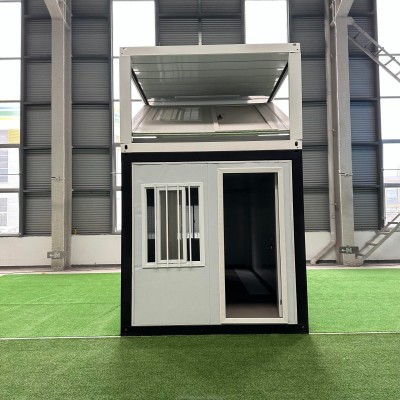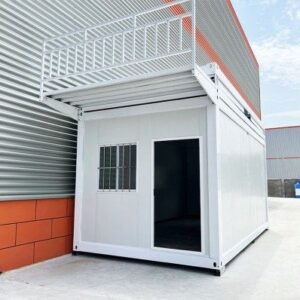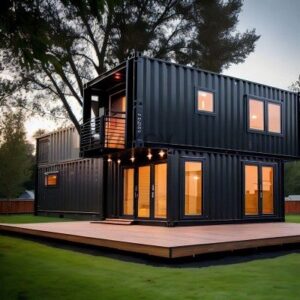Average Cost Range of Container House by Project Type and Size
When considering how much cost container house projects typically run, it really depends on the size, complexity, and location. Here’s a straightforward look at average cost ranges based on project type and size:
Small Basic Container House Cost Estimate
A small, basic container house—think of a single 20ft container converted into a tiny home or studio—can cost between $25,000 to $50,000. This price generally includes a used container, basic insulation, simple interior finishes, and minimal customizations. It’s a popular choice for those seeking affordable, quick housing solutions or guesthouses.
For example, our 20-foot container tiny house offers a compact, efficient space ideal for urban lots or backyard studios at accessible pricing.
Mid Size Family Container House Cost Estimate
For a mid-sized family home, often made by combining two to three containers, costs typically range from $70,000 to $150,000. This estimate accounts for added customization like multiple bedrooms, bathrooms, enhanced insulation, plumbing, electrical work, and moderate interior finishes.
This size strikes a balance between affordability and comfort, suitable for small families or those wanting more space than a tiny home without the price of traditional construction.
More details about multi-container homes can be found here: 2 Bedroom 20 ft Two Container House.
Large Custom Multi Container House Cost Estimate
Large, custom-built container homes, especially those involving multiple containers with extensive customization and high-end finishes, can range from $200,000 to $500,000 or more. These projects often include luxury features, solar panels, advanced HVAC systems, smart home tech, and premium materials. The work is labor-intensive and requires professional design and construction teams.
Regional Price Variations and Why They Matter
Where you build your container home in the U.S. significantly impacts costs. Here’s why:
- Labor Costs: Urban areas like San Francisco, New York, or Seattle tend to have higher labor rates compared to rural regions in the Midwest or South.
- Permits and Regulations: Some states or counties have strict building codes or special permits that add time and fees.
- Material Availability: Shipping containers and finishing materials might cost more if they need long-distance transport.
- Climate Considerations: Colder areas require better insulation and heating systems, increasing build costs.
- Land Prices and Site Prep: Location affects how much you’ll spend on foundation work, land clearing, or site prep.
For U.S. customers, it’s important to factor in these regional conditions when budgeting. Areas with moderate climates and flexible building codes generally offer the most cost-effective opportunities for container houses.
What Is a Container House
A container house is a type of home or building constructed primarily from repurposed shipping containers. These steel containers, originally designed for cargo transport, have become popular as a cost-effective, durable, and sustainable building option. Container houses can range from simple, single-container units to complex multi-container structures tailored for specific needs.
Types of Container Houses
- Single Container Homes: Built using one standard 20ft or 40ft container; ideal for tiny homes, studios, or small offices.
- Multi-Container Homes: Combine two or more containers to create larger living spaces with multiple rooms; suitable for families or extended living.
- Customized Container Homes: Tailored to specific designs, often incorporating cutting, welding, insulation, and architectural features for a fully personalized residence.
Common Uses of Container Houses
Container homes are versatile and serve a variety of purposes beyond residential use:
- Residential Homes: Affordable and modern housing options ranging from tiny homes to large family houses.
- Office Spaces: Quick-to-deploy modular offices for businesses and remote work.
- Pop-up Shops and Retail: Temporary or semi-permanent retail spaces with flexible designs.
- Emergency and Disaster Shelters: Rapidly deployable shelter solutions for crisis situations, offering durability and security.
By reusing shipping containers, these homes combine affordability with functionality, making them an attractive alternative to traditional construction for various applications across the US market.
Factors Affecting the Cost of a Container House
Understanding what drives the price of a container house helps you plan your budget better. Several key factors impact the overall cost, from the basic container price to features and labor.
Base Cost of Shipping Containers
- New vs Used Containers: New containers cost more but come in better condition, reducing initial repairs. Used containers are cheaper but might require more prep work.
- Size Matters: The two common sizes are 20ft and 40ft. Naturally, a 40ft container costs roughly double or more but offers more living space, affecting the price.
Customization Costs
- Modifications like cutting, welding, and reinforcing the container to add windows, doors, or adjust the layout add to costs.
- Insulation is a must for comfort and energy efficiency, with materials ranging from spray foam to panel insulation.
- Plumbing and electrical work bring up expenses depending on system complexity and local code requirements.
Labor Costs
- Choosing a DIY approach cuts labor fees but requires skills and time.
- Professional contractors ensure quality and compliance but add a significant portion to the budget.
Site Preparation Costs
- Your land might need clearing, leveling, or grading before the foundation goes in.
- Foundation options vary (pier, slab, or crawl space), each with its own cost impact.
Transportation and Delivery Fees
- Moving containers from the supplier to your site includes trucking and sometimes crane rental, especially with remote or difficult-to-access locations.
Permits, Legal Fees, and Inspections
- Local building codes often require permits and inspections, which can add fees and sometimes cause delays.
- Getting proper approvals in advance avoids costly legal issues later.
Interior Finishing Costs
- Choices in flooring, wall finishes, windows, doors, and fixtures greatly influence the final look and price.
- Higher-end finishes naturally push costs up.
Utilities Setup
- Connecting your container house to water, electricity, and sewage lines can vary greatly based on location.
- Remote sites might need alternative solutions, increasing costs.
Additional Features
- Installing solar panels or HVAC systems ups the initial investment but may save money long term.
- Smart home integrations like automated lighting or security add convenience and cost.
By considering these factors, you can anticipate what parts of your container home project will take the biggest slice of your budget. For more details on pricing structures, check out How Much Does a Container House Cost.
Cost Comparison Container House vs Traditional House
When deciding how much cost container house projects compare to traditional homes, it’s important to look beyond just the upfront price. Both options have varied costs over time and different impacts on the environment, maintenance, and durability.
Upfront Costs and Long Term Savings
Container houses often have a lower initial price because:
- The base structure (shipping container) is less expensive than building walls from scratch.
- Construction time is faster, reducing labor costs.
- Prefabricated components cut down on onsite work.
On average, building a container home may cost 20–30% less upfront than a traditional house of the same size. For example, a 40ft container house can range from $30,000 to $80,000 depending on customization, while a traditional home starts much higher.
Long term savings include:
- Lower utility bills with better insulation and modern HVAC setups in container homes.
- Reduced maintenance costs due to durable steel frames.
- Potential for solar panel integration to cut energy expenses.
Environmental and Sustainability Cost Implications
Container homes often win in environmental impact:
- Recycling shipping containers repurposes steel that would otherwise go unused.
- Production emissions are less compared to manufacturing new building materials.
- Smaller footprints save land and reduce waste from construction.
Traditional homes usually involve more waste, use more raw materials, and generally produce a larger carbon footprint during building.
Maintenance and Durability Cost Differences
Maintenance costs for container houses tend to be lower as:
- Steel containers resist pests like termites.
- Fewer repairs to siding and structural elements over time.
- Modern coatings protect against rust and weather.
Traditional homes might require frequent painting, wood repair, and more upkeep especially depending on local climate conditions.
| Aspect | Container House | Traditional House |
|---|---|---|
| Upfront Cost | Lower (20–30% less) | Higher |
| Construction Time | Faster, less labor | Longer, labor-intensive |
| Environmental Impact | Lower; uses recycled materials | Higher; more waste and emissions |
| Maintenance | Lower; steel is durable | Higher; regular upkeep needed |
| Energy Efficiency | Can be higher with insulation & solar | Varies, often less efficient |
For a detailed breakdown of shipping container home costs, including materials and labor, check out how much is it to build a container house.
Overall, container homes offer cost-effective alternatives with strong environmental and maintenance advantages compared to traditional houses, especially appealing to those in the U.S. looking for affordable and sustainable living options.

Tips to Save Money on Container House Building
Building a container house can get pricey, but there are several smart ways to cut costs without sacrificing quality or comfort. Here’s how to save money on your container house construction cost:
Buy Used Containers Instead of New
One of the biggest expenses is the container itself. Used shipping containers are significantly cheaper than brand-new ones. They often come in good condition, especially if certified, and can still last for decades once properly insulated and maintained. Just be sure to check for structural damage and hazardous chemicals.
Choose Smart Customization Options
Customization costs like cutting, welding, insulation, plumbing, and electrical work can add up fast. To keep costs down:
- Opt for simple layouts and avoid excessive modifications.
- Use standard container dimensions to limit costly alterations.
- Prioritize essential features over luxury finishes.
- Pick durable, cost-effective materials to reduce long-term maintenance.
Leverage Prefabricated Modules
Prefabricated container houses or kits reduce on-site labor and construction time. These modules are partially or fully built off-site under factory conditions, which lowers unexpected expenses and quality issues. Using prefab containers can trim down the overall budget while speeding up the build.
Check out more about prefab options here: Prefabricated Container House
DIY Elements Versus Hiring Experts
Labor can be pricey, especially in the US market. You can save money by doing some parts yourself, like painting, installing fixtures, or interior finishing.
However, hire professional contractors for crucial tasks such as welding, electrical wiring, plumbing, and foundation work to avoid costly mistakes and ensure safety.
Get Multiple Quotes and Budget Transparently
- Always request several quotes from container suppliers and contractors to compare pricing and services.
- Be upfront about your budget limitations and ask for cost-saving suggestions.
- Include a contingency fund of 10-15% to cover unexpected expenses.
- Keep track of all expenses regularly to avoid surprises.
By following these tips, you can keep your container home project affordable and aligned with your financial plan. For more details on budgeting, check this guide: How Much Does a Container House Cost.
Financing and Budget Planning for Container House Construction
When it comes to financing a container house, understanding your options and planning a realistic budget are crucial steps to avoid surprises down the road. Here’s what you need to know about typical funding sources, what lenders expect, and how to budget wisely for your container home project.
Typical Financing Options for Container Homes
Unlike traditional homes, container houses often require specialized financing, but several options are available:
- Personal Loans or Home Equity Loans: Many buyers use personal or home equity loans to cover shipping container home costs because these loans are flexible and accessible.
- Construction Loans: Some banks offer construction loans specifically for building container homes, which cover the purchase, site prep, and building costs. These are usually short-term loans requiring detailed project plans.
- Manufacturer Financing: Some container home kit suppliers offer in-house financing, which can simplify the process but check interest rates and terms carefully.
- FHA and VA Loans: These government-backed loans are limited for container homes due to appraisal challenges but may be available if the home meets certain permanent residence standards.
- Credit Cards or Savings: For small projects like tiny container homes, some buyers opt for personal savings or credit cards, though this can be expensive or risky.
What Lenders Look For in Container Home Projects
Lenders approach container home financing cautiously, focusing on:
- Permits and Zoning Compliance: Your project must comply with local codes to qualify for financing.
- Professional Plans: Detailed construction plans and cost estimates signal preparedness.
- Experienced Builders: Working with professional contractors or companies with experience helps lenders feel secure about the project’s success.
- Equity and Creditworthiness: A healthier credit score and some equity (if refinancing or using existing property) improve approval odds.
- Appraisals: Some lenders require property appraisal, which can be tricky for custom container homes but necessary for loans.
Creating a Realistic Budget for Your Container Home
Budgeting properly means factoring in all costs, including surprises. Here are key tips to build a smart budget with contingency funds:
- Start With Detailed Cost Breakdown: Include containers, customization, labor, permits, foundations, utilities, and interior finishing.
- Add a Contingency Buffer of 10-20%: This covers unexpected expenses like material price hikes or extra labor.
- Estimate Financing Costs: Consider interest payments, loan fees, and closing costs if you’re taking a loan.
- Plan for Ongoing Expenses: Don’t forget property taxes, insurance, and maintenance in your long-term budget.
- Consult Multiple Quotes: Getting several bids for labor and materials helps refine estimates and identify cost-saving options.
- Track Spending Closely: Use spreadsheets or budgeting apps to monitor costs throughout the build.
Proper financing and budgeting will keep your container house project on track and within your means, letting you focus on creating a comfortable, affordable home.
Container House Cost Case Studies from Yichen Customers
To give you a clear picture of how much a container house costs, here are some real examples from Yichen customers, along with detailed cost breakdowns and lessons learned.
Small Studio Container Home
- Project: 1 single 20ft container converted into a tiny home
- Cost Breakdown:
- Shipping container (used): $2,500
- Basic insulation and interior finishing: $7,000
- Electrical and plumbing setup: $3,000
- Labor (DIY with some pro help): $4,000
- Permits and site prep: $1,500
- Total Cost: Around $18,000
- Lessons learned: Choosing a used container and managing some work yourself helped keep costs low. Still important to invest in quality insulation to handle US climates.
Mid-Size Family Container House
- Project: Two 40ft containers combined for a 2-bedroom home
- Cost Breakdown:
- New shipping containers: $12,000
- Custom cutting, welding, and structural modifications: $15,000
- High-quality insulation, electrical, and plumbing: $10,000
- Professional labor: $20,000
- Interior finishing (flooring, fixtures): $8,000
- Utilities and permits: $4,000
- Total Cost: Around $69,000
- Tips from the project: Hiring pros for welding and utilities ensured safety and durability. Regional permits added some time and cost; plan ahead for these.
Large Custom Multi-Container Home
- Project: Custom 4-container house with solar panels and smart home features
- Cost Breakdown:
- New containers (4 x 40ft): $24,000
- Complex cuttings, windows, doors, HVAC installation: $40,000
- Premium insulation and interior design: $25,000
- Expert labor and site foundation: $35,000
- Utilities including solar panel setup: $15,000
- Permit, inspections, landscaping: $8,000
- Total Cost: Around $147,000
- Core takeaway: Investing in quality materials and green features boosts upfront costs but can save long-term on energy bills. Planning and expert labor are musts for large projects.
of Yichen Customer Insights
- New vs Used Containers: Buying used containers saves money but requires thorough inspection; new containers add to base cost but are easier to customize.
- DIY vs Professional Labor: DIY can lower costs but expect longer timelines and potential rework; pro contractors bring reliability.
- Permits and Inspections: These can cost 5-10% of your total budget and vary by state and county.
- Interior and Utilities: These are often underestimated but crucial for comfort and legality.
- Additional Features: Solar panels, HVAC, and smart home systems increase initial cost but add value and savings.
Container House FAQ
Can I Live in a Container House Permanently
Yes, you can live in a container house permanently. Many people in the U.S. choose container homes as their full-time residence. These structures meet building codes when properly insulated, ventilated, and fitted with utilities. Permanent living depends on local zoning laws and permits, so it’s essential to check regulations in your area before committing.
Are Container Houses Safe and Durable
Container houses are safe and durable when built correctly. Shipping containers are made from strong steel designed to withstand harsh sea conditions, making them sturdy and weather-resistant. Proper modifications like rust protection, insulation, and structural reinforcements help maintain safety and durability over time. However, poor construction or neglect can lead to issues, so professional help is recommended.
How Long Does It Take to Build a Container House
The timeline varies depending on size, complexity, and customization but typically takes 2 to 6 months from start to finish. Simple, single-container homes can be ready in a few weeks if using prefabricated designs. Larger multi-container homes with extensive customization may take several months to complete, including permits, foundation work, and interior finishing.
Do Container Houses Increase Property Value
Container houses can increase property value, especially in areas focused on sustainability and innovative housing. Their modern look, cost-efficiency, and quick build time attract buyers interested in alternative homes. However, resale value depends on location, build quality, and local market acceptance. Proper permitting and professional finishes improve value perception.
What Maintenance Is Involved with Container Houses
Maintenance for container homes is generally low to moderate, including:
- Rust prevention: Regular inspections and repainting to prevent corrosion.
- Insulation upkeep: Checking seals and insulation for moisture or damage.
- Structural checks: Monitoring for any wear, especially if the container is modified.
- Utilities maintenance: Standard upkeep for plumbing, electrical, and HVAC systems.
Following routine maintenance helps extend the lifespan and ensures your container house stays safe and comfortable



